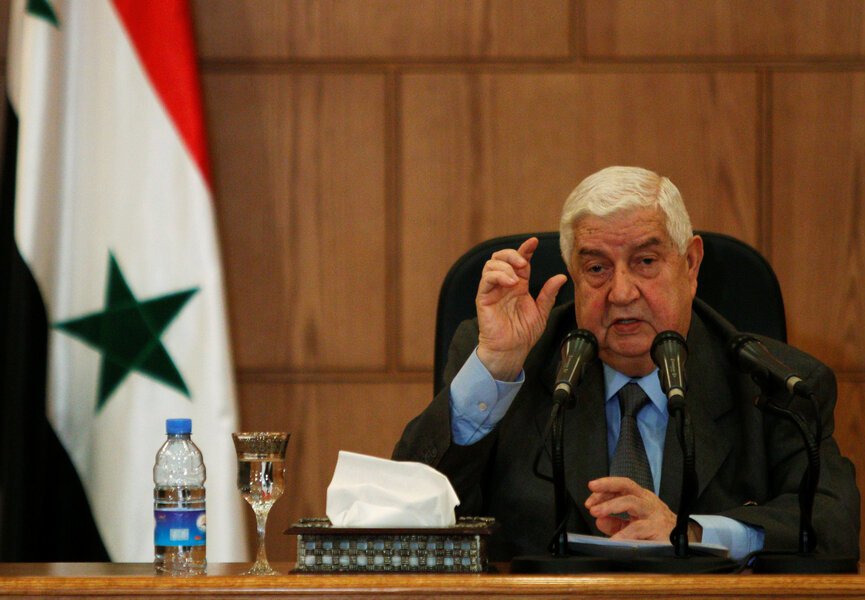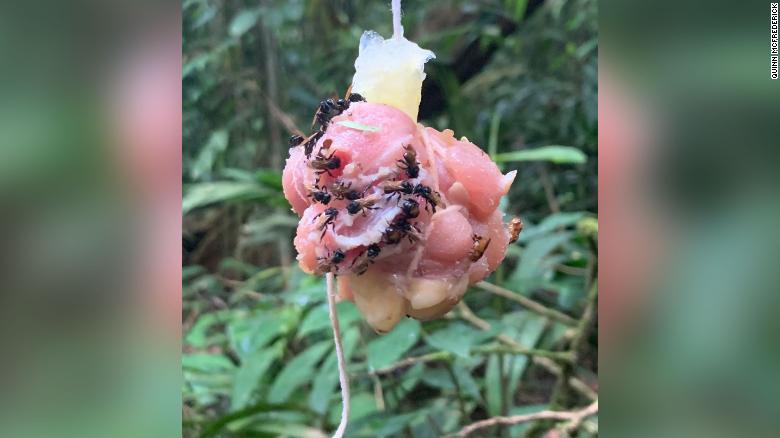
Inside a small aircraft, decorated with a polka-dot jaguar design, Ângelo Rabelo checks data on a small laptop computer. “We’re approaching a river spring!” he shouts over the plane’s noisy engine.
Below, the Paraguay river in Brazil’s Mato Grosso state snakes between clusters of vibrant green forest and extensive patches of farmland. The plane flies over a large, barren-looking stretch of light brown land where soy is being grown. A small buffer zone of trees separates the crops from the river, in which lies a pulsating spring.
Rabelo is the head of local NGO Instituto Homem Pantaneiro, which works to conserve the Pantanal region by monitoring waterways and promoting sustainable practices with the local population. The Paraguay river “is like the main artery feeding the veins of the Pantanal’s body – if this artery gets blocked, the whole body breaks down”, he says.
The Pantanal is the world’s largest wetland territory. Located mostly in Brazil but also covering Bolivia and Paraguay, the wetlands cover an area of 170,500 sq km – equivalent to the combined size of Belgium, Holland, Portugal and Switzerland. It’s home to 4,700 species of plant and wildlife, including endangered species such as jaguars, giant anteaters, giant armadillos and the hyacinth macaw. Thousands of local people make a living from the land, through small-time farming or fishing.
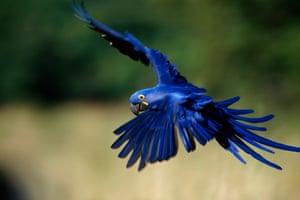
But the Pantanal’s waterways – essential to all life in the region – are threatened by deforestation, soil erosion from expanding industrial agriculture, and infrastructure projects.
Maintaining this unique region is an uphill struggle that requires a multi-pronged approach, but activists and local and international NGOs are taking on the challenge.
Some are Pantaneiro – as the locals are known – by birth, others by vocation. Whether their work involves monitoring and preserving the rivers that sustain the wetlands, keeping tabs on endangered species, or pushing for better protective legislation, they are united by a passion for the Pantanal that is both infectious and inspiring.
“Today, I still feel like the first time I arrived in the Pantanal,” says Rabelo, a former forest police colonel. “Seduced by the natural beauty and the constant renewal process of the waters.”
An influx of ‘asphalt farmers’

Mass farming in the region began in the 1960s under Brazil’s then military government. Following huge floods in 1974, many farms were brought to the edge of bankruptcy and land value plummeted.
Since then, and as Brazil’s economy grew during the 2000s, agriculture has made a comeback in the region, with cattle and soy two of the country’s biggest exports. In the past five years especially, the Pantanal has seen an influx of farmers from other parts of Brazil. They are known as “asphalt farmers” as they live in the cities instead of on the farms, unlike the traditional farmers of the region.
“They come to the Pantanal because of the cheap land prices,” says Dr Catia Nunes da Cunha, the coordinator of the Pantanal Ecological Studies Centre at the Federal University of Mato Grosso. “In Sao Paulo and Rio Grande do Sul, where there is good infrastructure, you can’t buy cheap land. They often acquire the land [in the Pantanal] for below market price because the local farmers are struggling to make a living.”
The change from local, mainly subsistence, farmers to macro-scale agriculture producers, who have no personal connection with the land and use intensive farming techniques and machinery, is regularly cited by academics and NGOs as one of the main threats facing the Pantanal.
According to WWF Brazil, some 40% of the total area of the upper Paraguay river basin in Brazil has already been deforested, and 30% of springs that feed the Pantanal are at ecological risk and require urgent action.
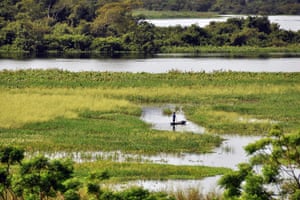
Analysts point to rising soy production in the region as an especially worrying trend due to the use of agrichemicals that can run into the waters.
“We don’t know where these chemicals are coming from or what’s in them. This is the frontier region, so chemicals that are banned in Brazil can be smuggled in from Bolivia and Paraguay,” says da Cunha.
Further complicating the situation is a severe lack of resources available to local police. In the Pantanal city of Cáceres, Captain Thiago Martins de Souza of the local environmental military police says his battalion has just 25 officers to cover 22 municipalities, and only one working 4×4 truck.
Instituto Homem Pantaneiro runs a project called Cabeceiras do Pantanal, which monitors nearly 1,000 water springs and areas of farmland near river banks via monthly plane excursions.
Results are sent to the research department of the local federal university for analysis and if there are any infractions, such as a farm encroaching too close to the banks of the river which can cause soil erosion and interfere with its flow, the environmental police are alerted and the property owner can face a hefty fine.

Photograph: Alamy Stock Photo
Infrastructure interrupting the environment
Beyond agriculture, the increasing use of hydroelectric dams to create energy in the region is also a major threat.
“If you put a series of dams together on one river, you are going to cause interruption to the environment,” says Júlio César Sampaio da Silva, the Cerrado Pantanal programme coordinator at WWF Brazil. In 2012, the organisation launched the Pantanal Pact, a project to protect the Pantanal’s waterways across 25 municipalities, 70 institutions, the public and private sectors, and civil society. The overuse of dams alters the Pantanal’s annual flood and drought patterns, he explains.
There are around 50 dams in the upper Paraguay basin, with another 80 planned. According to Pierre Girard, a professor at the Centre for Pantanal Research, 70% of the hydroelectric energy potential in the region has already been used, leaving just 30%, which will not bring significant benefits. “But it’s a profitable business, given the high cost of energy in Brazil,” he says.
A waterway connecting Brazil, Argentina, Bolivia and Uruguay to transport agricultural products to the ocean is also planned, but a construction date is still to be set.
“The Paraguay river is like a snake; it’s very curvy and they intend to make the waterway in a straight line. Can you imagine the kind of impact that this would have? This is a big problem,” says da Silva, referring to damage of the local ecosystem that would be caused if the river banks were altered artificially.
One million visitors a year
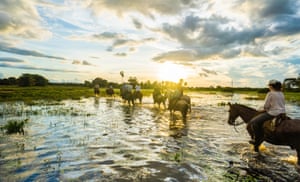
Flying from the Pantanal’s highlands – the Planalto – where the farms and dams are located, to the lowlands – the Planicie – soaring over vibrant green forests and shiny silver lakes , it’s easy to see why one million tourists pass through the Pantanal each year.
Ecotourism is a growing industry, upheld as a way to preserve the region and supplement the locals’ incomes.
At the Pousada Amolar guesthouse, a Unesco heritage site in the Pantanal conservation area of Serra do Amolar, vet Diego Viana works with Instituto Homem Pantaneiro to collect data from 30 cameras set up to monitor jaguars.
Part of Viana’s work involves visiting communities across the Pantanal and advising them not to kill jaguars, for which Pantaneiros can earn a great deal of money from rich cattle farmers. Viana says that an onceiro – a jaguar killer – can earn up to BR$1,000 (£250) from a wealthy farmer, the equivalent of a month’s wages. Killing jaguars in illegal in Brazil, but the perpetrator has to be caught red-handed.
Viana says that while farmers lose cattle to jaguars, therefore reducing profits, killing them is a short-sighted solution. “The jaguar is at the top of the food chain. Kill the jaguar and you will have more deer, more capybara – animals that transmit diseases to cattle,” he says.
Farmers cutting down trees to make more space is also an issue, adds Viana. “The more they degrade the environment, the more likely that a jaguar will attack their cattle.”
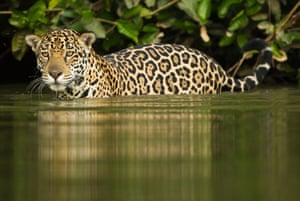
Pushing for a new law
Brazil’s forest code provides no specific protocol for the Pantanal. A recent, controversial change to the code in 2013 – brought in under pressure by the powerful agribusiness lobby – has reduced the buffer zone necessary between farmland and river springs, a potentially disastrous measure for the Pantanal. As such, activist groups have been pushing for a Pantanal-specific law.
“The constitution says that the Pantanal is national heritage and therefore a specific law should be created for it. We are trying to push for this at the moment,” says Girard.
The law would encompass all of the Pantanal and the Planalto highlands, and override the forest code. The original version of the law was submitted to the senate in 2011 by Blairo Maggi, the controversial former governor of Mato Grosso state and the current Brazilian minister of agriculture. He is popularly known as the Soybean King, in reference to the fact that between the 1990s and early 2000s, he was one of the world’s biggest producers of the commodity.
Since then, activist groups have been lobbying for the pending legislation to include better protection of the Pantanal and its people.
“It’s a law about restriction of use – things you can and can’t do, using the concept of micro habitats. For example: ‘In this place you can do this, but in this place you can’t do that’,” says Girard. “You have to have rule of law.”
[Source:- The Guardian]



